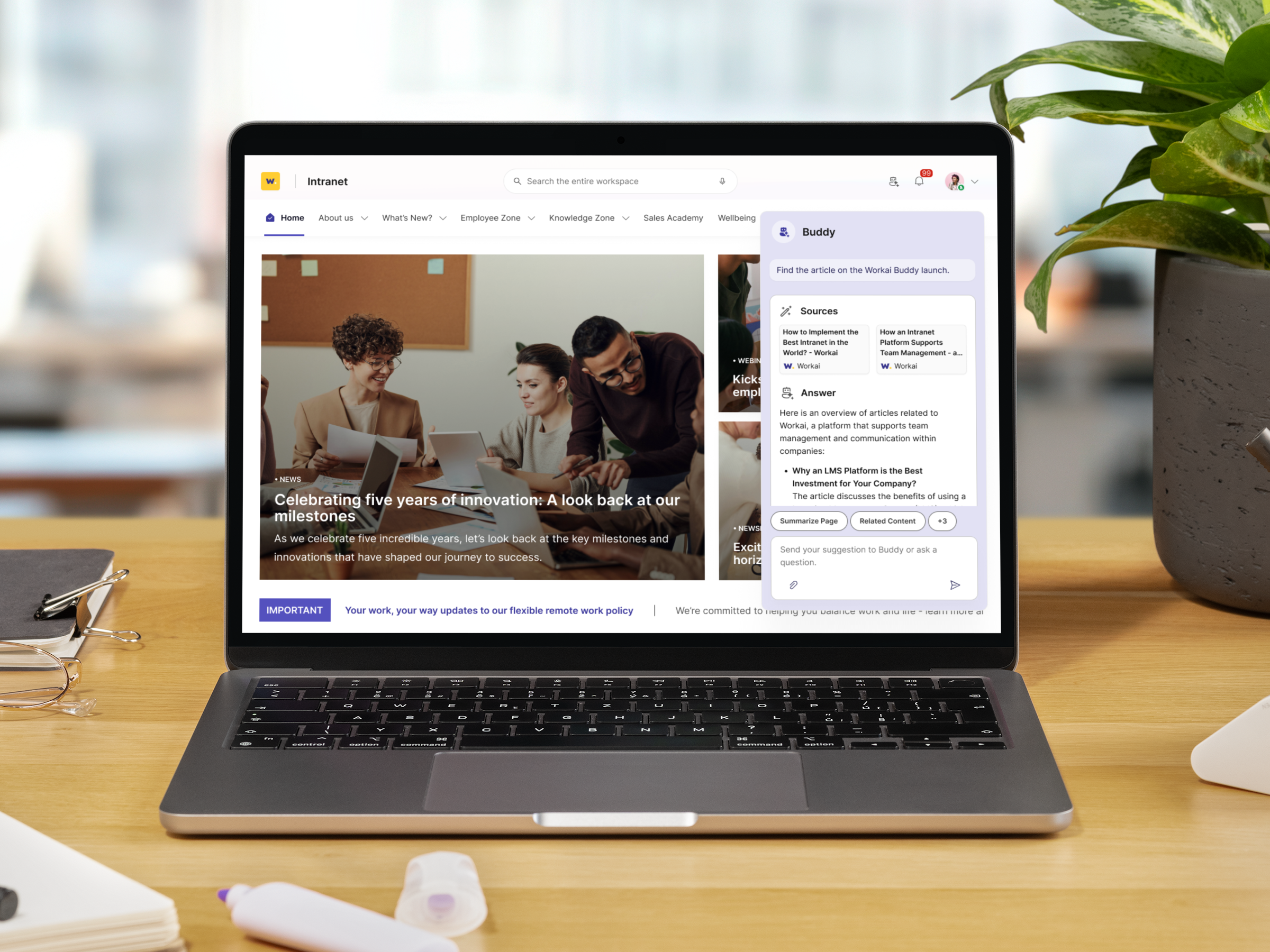
5 applications of AI in Employee Experience
Artificial Intelligence (AI) is no longer just a technological curiosity—it’s becoming a practical support tool in the everyday functioning of organizations. In the realm of Employee Experience (EX), its role is growing rapidly. More and more often, AI is responsible for delivering relevant communication, intuitive processes, and high-quality employee interactions. It enables large-scale personalization, predicts team needs, and automates HR operations. But AI isn’t just about technology—it delivers real results that improve engagement, productivity, and talent retention. In this article, we explore five areas where AI truly makes a difference—and how modern organizations are already benefiting from it.
1. Personalized content powered by AI in Employee Experience
One of the most common—and effective—uses of AI in Employee Experience is the personalization of content and employee journeys. AI analyzes user behavior, organizational roles, training history, and communication preferences to deliver relevant recommendations—from articles and announcements to courses and career paths.
This matters because, in the age of information overload and short attention spans, communication relevance is critical. Employees don’t want to search for what they need—they want it delivered instantly. For companies, this translates into higher engagement, more effective HR efforts, and better development outcomes. A great example is Żabka Polska, which implemented the AI-supported Workai Learning platform. The system analyzes users’ progress and automatically recommends content tailored to their level and work context. The result? Faster onboarding and more relevant, effective training.

2. AI as a virtual employee assistant
AI assistants integrated into Employee Experience Platforms (EXP) support employees with everyday tasks—from finding information and submitting leave requests to summarizing meetings. Using natural language processing (NLP) and access to internal data, they can answer questions, suggest documents, or translate messages.
This is important because it saves time, reduces the burden on HR and IT departments, and empowers employees to act independently. For organizations, that means greater efficiency, fewer errors, and less frustration when navigating systems. A great example is Workai Buddy—an AI assistant that supports intranet editors and employees. It can summarize documents, suggest titles, answer questions about internal policies, and even assist with creating visuals for publications.
3. Predicting employee sentiment and attrition risk
AI in Employee Experience Platforms (EXPs) can analyze employee sentiment and predict turnover risk using data like system activity, tone of communication, survey results, or engagement trends. This is essential because traditional satisfaction surveys often come too late—by the time an issue is visible, it’s already a problem. Predictive analytics enables proactive interventions, like 1:1 conversations, tailored development offers, or flexible work arrangements.
For companies, this means lower attrition, improved morale, and stronger trust. One example is an organization that integrated data from its intranet, LMS, and pulse surveys—AI detected early signs of burnout in several team members. Managers were able to respond in time, preventing the loss of key talent.
4. Automating HR processes with AI
AI-powered HR automation helps streamline repetitive tasks such as leave requests, onboarding, performance reviews, benefits management, and updating personal data. This is especially important in large organizations where HR teams often face overwhelming volumes of requests.
With AI, these processes can be completed quickly and accurately, without direct human involvement, and always in line with company policies. This results in time savings, scalability, and increased employee satisfaction—especially when they can manage HR matters independently through EXP apps, even on mobile. For example, one company fully automated onboarding—from account creation and equipment allocation to assigning training modules and sending a welcome message from the manager. AI tracked progress and issued reminders for the next steps.

5. Decision support powered by AI
AI is becoming an advisor for HR and leadership teams, supporting data-driven decision-making. It processes large data sets—from engagement metrics and team performance to survey feedback—and turns them into actionable insights that would otherwise require weeks of analysis.
This is particularly valuable in fast-moving, distributed environments, where timely and accurate decisions can impact morale, productivity, and retention. In practice, this means managers no longer need to sift through dashboards manually—they receive clear suggestions, such as which team members need support, what actions could improve morale, or when to schedule a 1:1. One company used AI to analyze communication patterns in its sales team—when the system detected rising frustration, the manager was able to act before a wave of resignations occurred.
How Workai Implements AI in Employee Experience
AI isn’t just a trendy add-on; it’s a real driver of more modern, effective, and human-centered workplaces. That’s why at Workai, we’re developing a suite of AI-powered features designed to help users create content faster, communicate more accurately, and make better decisions.
Our AI solutions, offered under the name Workai Intelligence, include intelligent content recommendations, the Workai Buddy assistant, and predictive EX analytics. Intranet editors can generate titles, summaries, or visual prompts, while HR managers get access to mood analysis and actionable engagement recommendations.
What’s more, our learning module will soon enable the creation of virtual trainers. AI-powered avatars will deliver personalized, video-based training without the need for cameras, actors, or studio time. It’s a game-changer for onboarding and employee development, available instantly and directly from your browser.
We believe AI doesn’t replace people, it supports them where time, relevance, and experience quality matter most. Our goal is to build a platform that keeps the human touch while using the power of AI to make daily work simpler, more intuitive, and tailored to each employee’s needs.
While AI’s role in the workplace is still evolving, it’s already clear that data-driven technologies are transforming Employee Experience. From personalized communication and virtual assistants to predictive analytics. AI is reshaping how organizations engage with their people. And it’s not just about efficiency, it’s about improving the quality of experiences and tailoring them to human needs. Organizations that learn how to harness AI’s potential will have a distinct advantage: they’ll react faster, engage better, and build workplaces fit for the future. And this is just the beginning.
